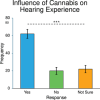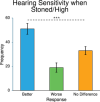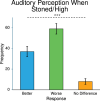Exploring the interaction between cannabis and music
- PMID: 40836496
- PMCID: PMC12448268
- DOI: 10.1111/nyas.70010
Exploring the interaction between cannabis and music
Abstract
Cannabis use has long been associated with enhanced music experiences, yet scientific research on its effects on auditory perception remains limited. This convergent mixed-methods self-report study investigated how recreational cannabis users experience auditory stimulation and music in particular. A total of 104 participants completed an online questionnaire, 15 of which were selected to participate in an optional semi-structured interview. Quantitative analyses showed that listening to music was the most commonly reported activity while high, indicated by 45% of participants. Participants reported significantly greater hearing sensitivity (p < 0.001) and state absorption in music (p < 0.001) while high compared to sober. Higher trait absorption in music was associated with greater state absorption in music while high. Qualitative thematic analysis identified four main themes: (1) altered cognitive processes and reinterpretations, (2) auditory perceptual effects from new sensations to sensory overload, (3) emotional openness, sensitivity, and regulation, and (4) embodiment, immersion, and out-of-body dissociation. This study provides a novel theoretical framework to understand the complex interactions between cannabis and musical experience.
Keywords: absorption; cannabis; hearing; music; reward.
© 2025 The Author(s). Annals of the New York Academy of Sciences published by Wiley Periodicals LLC on behalf of The New York Academy of Sciences.
Conflict of interest statement
The authors declare no conflicts of interest.
Figures





References
-
- Centers for Disease Control and Prevention . (2024). Cannabis facts and statistics . Retrieved from https://www.cdc.gov/cannabis/data‐research/facts‐stats/index.html
-
- Statistics Canada . (n.d.). Cannabis consumption in Canada . Retrieved July 2, 2024, from https://www.statcan.gc.ca/o1/en/plus/6091‐cannabis‐consumption‐canada
-
- Balneaves, L. G. , Hammond, D. , Turner, S. , Nickel, N. , Woodgate, R. L. , & Watling, C. Z. (2024). Youth and young adults’ knowledge and perceptions of risks and benefits regarding cannabis products: A cross‐sectional analysis of over 1,700 individuals. Journal of Psychoactive Drugs, Advance online publication. 10.1080/02791072.2024.2371028 - DOI - PubMed
-
- Tart, C. T. (1971). On being stoned: A psychological study of marijuana intoxication. Science & Behavior Books.
MeSH terms
LinkOut - more resources
Full Text Sources

